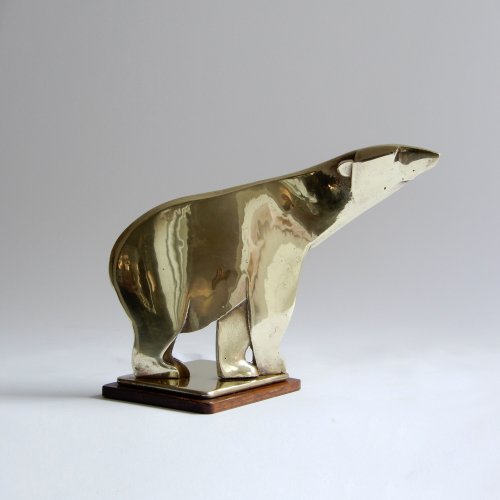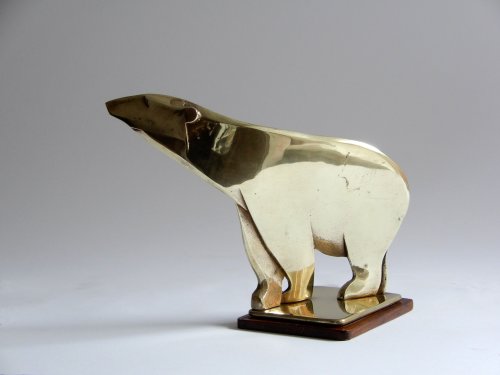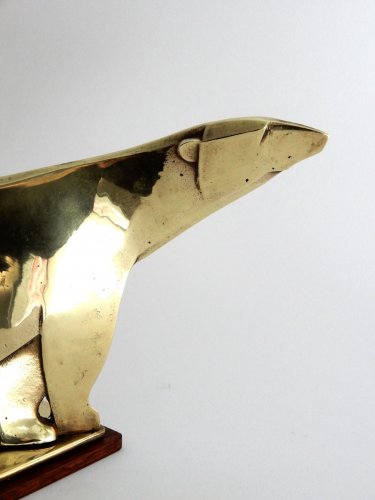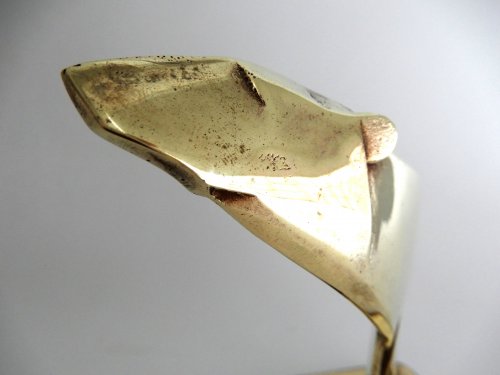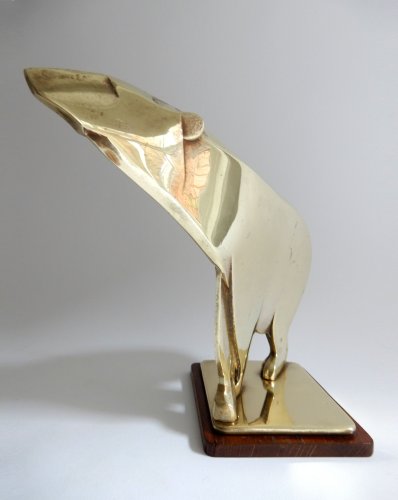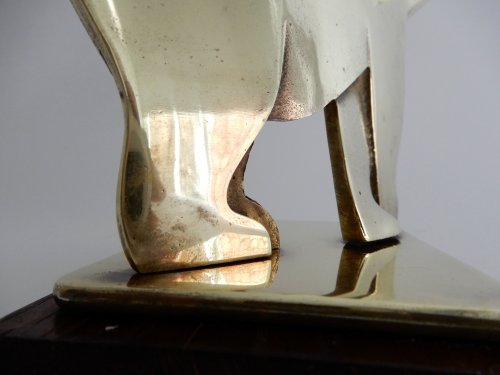Karl Hagenauer (Att) (1898-1956), Wiener Werkstätte Hagenauer Polar bear
About this piece
Beautiful stylized polar bear. The great thing about this design is that the animal's character and even its pose is very well rendered and yet very artfully designed. There seems to be an optical illusion, because it almost looks like a relief, it is only 2 cm deep. Yet the beast is round and comes to life beautifully. There are several animals in this style designed by Hagenauer, in the period 1945-1950.
It is a very characteristic Hagenauer design, yet I have awarded this polar bear to the Werkstätte Hagenauer for good measure because the signature is missing. The wooden plate under the brass base is not original, which is probably why the well-known signature is missing
Biography:
The name of Karl Hagenauer (Austria, 1898-1956) is inextricably linked to his brother Franz (Vienna, 1906-1986) and the Wiener Werkstätte Hagenauer.
His father Carl founded this company in 1898 and made all kinds of small bronzes, decorative items, but also consumer goods.
At the age of 12 he sent his sons, both talented, to Franz Cizek's youth courses at the Kunstgewerbeschule, the Academy of applied arts in Vienna. They also received their education there, Karl studied architecture with Josef Hoffmann and Oskar Strnad.
Franz studied sculpture with Anton Hanak and Josef Hoffmann. He also did an internship with Dagobert Peche at the Wiener Werkstätte.
Karl was very talented in design and drawing, he stylized animal figures and other figures, often handmade from bronze or brass, his stylized representation of Josephine Baker is well known. In addition, he was also very professional in business and immediately after his studies in 1919 started working for the family business. After their father's death took charge in 1928.
Both brothers designed for the firm, they were also closely associated with the Wiener Werkstätte, whose influence was great. Artists such as Otto Prutscher, Josef Hoffmann and F.J. Merkel, designs made for Hagenauer Werkstätte. In 1930 Julias Jirasek (1896-1966) was also hired. Like Karl, he had been educated at the Academy with Oskar Strnad.
The brothers used various materials for their sculptures and decorative objects such as mirrors and candlesticks, first mainly bronze and brass, later also in wood, nickel-plated metal, silver and even ivory.
Their work was very popular, in Europe, but also in the United States. They exhibited at the various world exhibitions and received various prizes, such as in London, Monza and Paris (1925). They gained even more international recognition and buyers.
Karl died in 1956 and his brother Franz took over, eventually the renowned Werkstätte Hagenauer closed its doors for good after Franz's death in 1986.
The designs and sculptures of Karl and Franz Hagenauer are still very popular today. Their work is also part of many a collection in the Museums. In Vienna, the Hagenauer Werkstätte is considered to be of great importance and seen as a representation of the Viennese Arts & Crafts.
Literature:
- Alistair Duncan; 'Art Deco Sculpture', Thames & Hudson, London 2016. P. 258-265.
- Christian Brandstatter, Daniela Gregori, Rainer Metzger; 'Vienna 1900', Librero 2018, p.266-269, 462 and 463.
(Original title 'Vienna 1900 Complete', Thames $ Hudson, 2018.)
- 'Modern work of Metalwork', Bröhan Museum Berlin, 1990. P. 510-517.
Condition
Uitstekend, het houten plaatje onder de sokkel is vervangen.
Material:
Brass
Measurements:
Length: 25 cm
(9,84")
Height: 17 cm
(6,69")
Depth: 2 cm
(79")
Period:
1945-50
Origin:
Austria
Artist / atelier:
Karl Hagenauer (Att), Wiener Werkstätte Hagenauer
